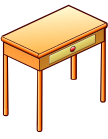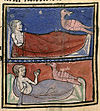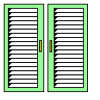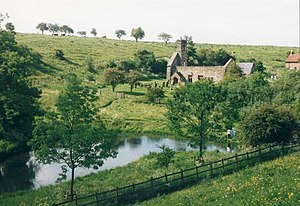Wharram Percy/Farming und Wharram Percy/Living: Unterschied zwischen den Seiten
(l) Markierung: 2017-Quelltext-Bearbeitung |
(l) Markierung: 2017-Quelltext-Bearbeitung |
||
| Zeile 1: | Zeile 1: | ||
[[File: | {{Aufgabe-en| | ||
# Read the text. | |||
# Do the interactive exercises. | |||
}} | |||
Welcome to our house. I live here with my husband Henry. He's taking the oats to the mill<ref>mill = place where corn is ground into flour<br>[[File:Poldermolen Zwaantje, Nijemirdum. 26-05-2020 (actm.) 06.jpg|100px]]</ref> today as one of his services to the Lord of the Manor. We have two girls, Emily who is 8 and Matilda who is 6. They are out in the wood collecting fallen branches for the fire. | |||
[[File:Wattle_and_daub_construction.jpg|thumb|300px|center|[[Wharram Percy/Glossary#Wattle and Daub|Wattle and Daub]]]] | |||
The walls are made of [[Wharram Percy/Glossary#Wattle and Daub|Wattle and Daub]]. That's thin branches of wood woven together and then covered with Daub, a mixture of clay, oxhair and dung. The roof is thatched with straw that we are given by the Lord. It’s a bit leaky<ref>leaky = A roof is leaky, if it isn't waterproof and rain comes through</ref> now but it's the harvest soon and we will repair it then. It's a bit dark inside as there is only one very small window. Only the Manor House and the church can afford glass in their windows. We put up a wooden shutter to keep the draughts out. We built the house with the help of our neighbours John the Carter and his wife Jane. | |||
[[File:Thatched_Roof_Inside_View.jpg|thumb|300px|center|thatched Roof]] | |||
Its smoky inside, there’s no chimney. Your eyes will get used to the light in a minute. Yes there's only the one room. A few of the villagers have two rooms in their house. It is a bit crowded especially in winter when we keep our cow at the end of the room. That's right: the floor is just flattened earth. | |||
As you can see the room is very bare, some small wooden stools, a table and a wooden chest in which we keep all our belongings. That's the water jug on the table. I have to go and fill it about five times a day. It's quite a walk to the stream and back. We all sleep in the corner of the room on a bed of straw. Henry is going to build a bed when he has time so we don't have to lie on the floor. The smoke from the fire in the middle of the room is the worst thing, the children never stop coughing<ref>to cough [kɒf] = If you can't breathe, you must cough (=husten)</ref> in winter. | |||
== Interactive exercises == | |||
=== Furniture === | |||
Not all the poor people had all of that, but find the pairs: | |||
== | <div class="memo-quiz" lang="en"> | ||
{| | |||
|- | |||
| [[File:Liberty - Stool Thebes - 1884.jpg|130x130px]] || stool | |||
|- | |||
| [[File:Table axo.svg|130x130px]] || table | |||
|- | |||
| [[File:Treasure_chest.svg |100px]] || chest | |||
|- | |||
| [[File:Caladrius.jpg|100px]] || bed | |||
|- | |||
| [[Datei:Clipart-shutter.svg|100px]] || shutter | |||
|- | |||
| [[File:Windsor Chair.svg|130x130px]] || chair | |||
|- | |||
| [[Datei:Clipart-bench.svg|100px]] || bench | |||
|} | |||
</div> | |||
== | === "making" your bed === | ||
Put in the correct words in the gaps: | |||
<div class="lueckentext-quiz" lang="en"> | |||
In the medieval ages people didn't have a ''bedroom''. They were "making" their bed in the ''great hall'' of a manor or in the only room of a farm house. | |||
When they were tired they put all the ''benches'' next to the wall and rolled out their ''bed rolls'' onto the floor. | |||
Only the richest people had their own bed. It had four posts in all the corners and a panel on top of it. It helped against ''bedbugs'' falling from the ceiling. | |||
On the side there were ''curtains'' which could be ''shut''. This was important because the squires and knaves slept in front of the bed in the same ''room''! | |||
</div> | </div> | ||
{{Fortsetzung| | {{Fortsetzung| | ||
weiterlink=Wharram Percy/ | vorherlink=Wharram Percy/Farming|vorher=Fields & Farming| | ||
weiterlink=Wharram Percy/Food and Drink|weiter=Food and Drink}} | |||
{{Wharram Percy}} | |||
<references/> | |||
Version vom 21. November 2020, 06:52 Uhr
- Read the text.
- Do the interactive exercises.
Welcome to our house. I live here with my husband Henry. He's taking the oats to the mill[1] today as one of his services to the Lord of the Manor. We have two girls, Emily who is 8 and Matilda who is 6. They are out in the wood collecting fallen branches for the fire.
The walls are made of Wattle and Daub. That's thin branches of wood woven together and then covered with Daub, a mixture of clay, oxhair and dung. The roof is thatched with straw that we are given by the Lord. It’s a bit leaky[2] now but it's the harvest soon and we will repair it then. It's a bit dark inside as there is only one very small window. Only the Manor House and the church can afford glass in their windows. We put up a wooden shutter to keep the draughts out. We built the house with the help of our neighbours John the Carter and his wife Jane.
Its smoky inside, there’s no chimney. Your eyes will get used to the light in a minute. Yes there's only the one room. A few of the villagers have two rooms in their house. It is a bit crowded especially in winter when we keep our cow at the end of the room. That's right: the floor is just flattened earth.
As you can see the room is very bare, some small wooden stools, a table and a wooden chest in which we keep all our belongings. That's the water jug on the table. I have to go and fill it about five times a day. It's quite a walk to the stream and back. We all sleep in the corner of the room on a bed of straw. Henry is going to build a bed when he has time so we don't have to lie on the floor. The smoke from the fire in the middle of the room is the worst thing, the children never stop coughing[3] in winter.
Interactive exercises
Furniture
Not all the poor people had all of that, but find the pairs:
"making" your bed
Put in the correct words in the gaps:
In the medieval ages people didn't have a bedroom. They were "making" their bed in the great hall of a manor or in the only room of a farm house.
When they were tired they put all the benches next to the wall and rolled out their bed rolls onto the floor.
Only the richest people had their own bed. It had four posts in all the corners and a panel on top of it. It helped against bedbugs falling from the ceiling.
On the side there were curtains which could be shut. This was important because the squires and knaves slept in front of the bed in the same room!
- Fields & Farming
- Living (House and Furniture)
- Food & Drink
- Fashion & Clothes
- Manor House
- A Knight's Tale
- Feudal System
- The Blacksmith
- Manorial Court
- How did the village get lost?
- How was the village rediscovered?
- Glossary














